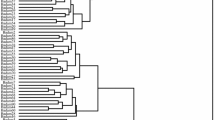Summary
Cultivated almonds (Prunus dulcis (Miller) D.A. Webb) in Morocco are still propagated from seeds by farmers to overcome transplant failure of grafted trees. Almond collections in southern Morocco conducted since 1975 have resulted in the selection of clones planted at 3 experimental stations. Principal component analysis (PCA) was used to compare kernel, nut, leaf, and growth habit characteristics among 67 selected Moroccan clones and 14 introduced cultivars. Clustering of clones from similar countries and collection areas would suggest the existence of different almond populations. The Moroccan clones did not cluster separately from the foreign cultivars. Three Moroccan clones had exceptionally large nuts and kernels while 7 selections had high yield potential due to high spur density. Moroccan selections tended to be characterized by small leaves in comparison to foreign cultivars. No evidence was found to suggest the existence of separate populations within the Moroccan almond germplasm.
Similar content being viewed by others
References
Anonymous, 1990. Secteur amandier. Bilan de la campagne 1989–1990. Division de l'Horticulture. Direction de la Production Végétale. Ministère de l'Agriculture et de la Réforme Agraire. pp. 1–3.
Barbeau G. & A.ElBouami, 1979. Prospection de tardivité de floraison chez l'Amandier dans le sud Marocain. Fruits 34(2): 131–137.
Barbeau G. & A.ElBouami, 1980a. Prospections ‘Amandier’ dans le sud Marocain. Fruits 35(1): 39–50.
Barbeau G. & A.ElBouami, 1980b. Les hybrides amandier x pecher naturels du sud Marocain. Fruits 35(3): 171–176.
Broschat T.K., 1979. Principal component analysis in horticultural research. HortScience 14(2): 114–117.
Daudin, J., 1982. Analyse en composantes principales. Mathematique et Informatique Document. Institut National Agronomique. Paris Grignon. pp. 1–63.
El Khatib-Boujibar, N., 1983. Le Maroc et Carthage. Le Memorial du Maroc (I). Nord Organisation ed. p. 140.
Kester, D.E. & R. Asay, 1975. Almonds. In: J. Janick & J.N. Moore (Eds), pp. 387–419. Advances in Fruit Breeding. Purdue Univ. Press.
Kester D.E., T.M.Gradziel & Ch.Grasselly, 1991. Almonds (Prunus). Genetics Resources of Temperate Fruits and Nut Crops. Acta Hort. 290: pp. 701–758.
Laghezali M., 1985. L'Amandier au Maroc. Options Mediterraneennes 85(1): 91–96.
Phillipeau, G., 1986. Comment interpreter les résultats d'une analyse en composantes principales. ITCF document. Institut Technique des Céréales et des Fourrages. pp. 1–28.
SAS Institute, Inc. 1985. SAS user's guide: Statistics. 5th edition. SAS Institute, Inc., Cary, N.C.
Author information
Authors and Affiliations
Rights and permissions
About this article
Cite this article
Lansari, A., Iezzoni, A.F. & Kester, D.E. Morphological variation within collections of Moroccan almond clones and Mediterranean and North American cultivars. Euphytica 78, 27–41 (1994). https://doi.org/10.1007/BF00021395
Received:
Accepted:
Issue Date:
DOI: https://doi.org/10.1007/BF00021395




